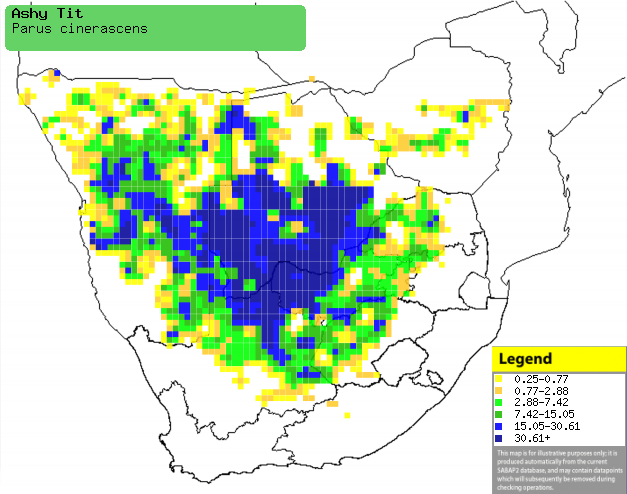|
Parus cinerascens (Ashy
tit)
Akasiagrysmees [Afrikaans]; Acacia-mees [Dutch]; Mésange
cendrée [French]; Aschenmeise [German]; Chapim-cinzento [Portuguese]
Life
> Eukaryotes >
Opisthokonta
> Metazoa (animals) >
Bilateria >
Deuterostomia > Chordata >
Craniata > Vertebrata (vertebrates) > Gnathostomata (jawed
vertebrates) > Teleostomi (teleost fish) > Osteichthyes (bony fish) > Class:
Sarcopterygii (lobe-finned
fish) > Stegocephalia (terrestrial
vertebrates) > Tetrapoda
(four-legged vertebrates) > Reptiliomorpha > Amniota >
Reptilia (reptiles) >
Romeriida > Diapsida > Archosauromorpha > Archosauria >
Dinosauria
(dinosaurs) > Saurischia > Theropoda (bipedal predatory dinosaurs) >
Coelurosauria > Maniraptora > Aves
(birds) >
Order: Passeriformes > Family: Paridae
Distribution and habitat
Near-endemic to southern Africa, occurring in the arid
savannas woodlands of Botswana and the Kalahari Desert in South Africa and
Namibia, extending marginally into south-western Angola. It also has a disjunct
population in Zimbabwe, specifically in areas where the miombo (Brachystegia)
woodland has been replaced with thorny woodland, thus displacing the
Miombo tit.
|
 |
|
Distribution of Ashy tit in southern Africa, based
on statistical smoothing of the records from first SA Bird Atlas Project
(©
Animal Demography unit, University of
Cape Town; smoothing by Birgit Erni and Francesca Little). Colours range
from dark blue (most common) through to yellow (least common).
See here for the latest distribution
from the SABAP2. |
Brood parasites
It has been recorded as host of the
Greater honeyguide.
Food
It eats mainly eats insects, especially caterpillars and
beetles, supplemented with fruit and seeds. It forages in the tree canopy,
sometimes rapidly pecking Acacia erioloba (Camel thorn) pods in search of
seed parasites. The following food items have been recorded in its diet:
Breeding
- The nest is a thick pad built of animal hair and fine plant fibres,
usually placed in either a natural tree cavity or an old barbet or
woodpecker nest. It also has occasionally been recorded to nest in
horizontal and vertical pipes.
- Egg-laying season peaks from October-December.
- It lays 3-6 eggs, which are incubated solely by the female for
approximately 14-15 days. The male brings her food once every hour or so,
each visit involving both birds rapidly quivering their wings.
- During the first week of the chick's lives the female broods and feeds
them with food given to her by the male at the nest entrance. Thereafter
both sexes forage and give food to their young, who leave the nest at about
20-22 days old.
Threats
Not threatened.
References
-
Hockey PAR, Dean WRJ and Ryan PG 2005. Roberts - Birds of
southern Africa, VIIth ed. The Trustees of the John Voelcker Bird Book
Fund, Cape Town.
|
